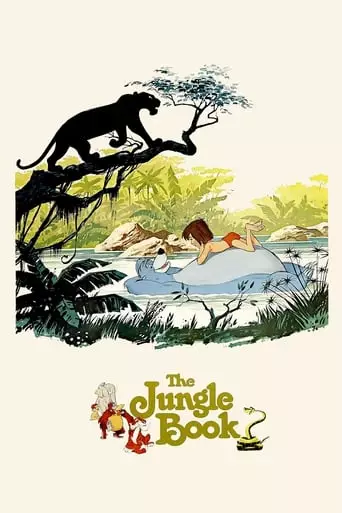The boy Mowgli makes his way to the man-village with Bagheera, the wise panther. Along the way he meets jazzy King Louie, the hypnotic snake Kaa and the lovable, happy-go-lucky bear Baloo, who teaches Mowgli The Bare Necessities of life and the true meaning of friendship.
The Jungle Book (1967) is a classic animated film produced by Walt Disney Productions, loosely based on Rudyard Kipling’s stories. The narrative follows Mowgli, a young boy raised by wolves in the jungles of India. As Mowgli grows, the jungle becomes increasingly perilous due to the presence of Shere Khan, a menacing tiger who harbors a deep-seated hatred for humans. Recognizing the danger, Bagheera, a wise panther, and Baloo, a carefree bear, decide to escort Mowgli to the nearby man-village for his safety.
Throughout their journey, Mowgli encounters various jungle inhabitants, including King Louie, an orangutan who desires to learn the secret of fire, and Kaa, a hypnotic python. Despite these distractions, Mowgli remains resistant to leaving the jungle, feeling a strong connection to his animal companions. The story culminates in a confrontation with Shere Khan, where Mowgli’s resourcefulness and bravery come to the forefront, leading to a resolution that allows him to choose his own path.
Main Themes in The Jungle Book
- Self-Discovery and Identity: Mowgli’s journey is fundamentally about understanding who he is and where he belongs. Raised by wolves, he grapples with his human identity and the expectations of the human world. His adventures and interactions with various characters help him realize his true nature and the importance of self-awareness.
- Friendship and Loyalty: The relationships between Mowgli, Bagheera, and Baloo exemplify the themes of friendship and loyalty. Despite their differences, these characters demonstrate unwavering support and care for one another, highlighting the value of companionship and trust.
- The Balance Between Freedom and Responsibility: The film explores the tension between the carefree freedom of jungle life and the responsibilities that come with human society. Mowgli’s reluctance to leave the jungle reflects his desire for freedom, while the looming threat of Shere Khan underscores the responsibilities and dangers of the outside world.
- The Influence of Environment on Character: The diverse characters Mowgli encounters, each shaped by their environment, illustrate how surroundings influence behavior and personality. From the carefree Baloo to the menacing Shere Khan, the film portrays how the jungle environment molds its inhabitants.
Impact of The Jungle Book
Upon its release, The Jungle Book received positive reviews for its animation, music, and character development. Critics praised the film’s lively characters and memorable songs, noting that it was one of Disney’s most entertaining films of the era. The film’s success at the box office, grossing over $142 million, demonstrated its widespread appeal and solidified its status as a classic in animated cinema.
Over the years, The Jungle Book has been recognized for its significant contribution to the animation industry, particularly in character animation. The film’s expressive character designs and fluid animation set a new standard for animated features. Its influence is evident in subsequent Disney films and adaptations, showcasing its enduring legacy in popular culture.
7 Reasons to Watch The Jungle Book (1967)
- Timeless Animation: The film showcases Disney’s classic animation techniques, featuring vibrant colors and expressive character designs that bring the jungle to life. The fluid animation enhances the whimsical and magical elements of the story.
- Memorable Characters: From the carefree Baloo to the menacing Shere Khan, the film introduces a cast of characters that are both entertaining and endearing. Each character is uniquely crafted, adding depth and charm to the narrative.
- Catchy Music and Songs: The film features a delightful musical score with memorable songs like The Bare Necessities and I Wan’na Be Like You. These tunes are catchy and have stood the test of time, enhancing the film’s appeal.
- Engaging Storytelling: The narrative is both entertaining and thought-provoking, exploring themes of self-discovery, friendship, and the balance between freedom and responsibility. The story’s simplicity allows for a focus on character development and moral lessons.
- Cultural Significance: As one of Disney’s most beloved classics, The Jungle Book holds a special place in animation history. Its influence can be seen in various adaptations and references in popular culture.
- Family-Friendly Entertainment: With its lighthearted humor and positive messages, The Jungle Book is suitable for viewers of all ages. It offers wholesome entertainment that can be enjoyed by children and adults alike.
- Nostalgic Value: For those who grew up with Disney classics, this film offers a nostalgic trip back to the golden age of animation. Its timeless appeal continues to resonate with audiences, evoking fond memories of childhood.
How Will You Feel After Watching The Jungle Book?
After watching The Jungle Book, you may feel a sense of warmth and nostalgia, especially if you have fond memories of classic Disney films. The film’s lighthearted humor and whimsical storytelling provide an enjoyable experience that leaves you with a smile. The charming animation and memorable characters contribute to a sense of satisfaction and contentment. While the film may not delve deeply into complex themes, it offers a delightful escape into a magical world, leaving you with a sense of joy and a renewed appreciation for the simple pleasures of storytelling.

